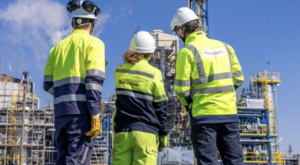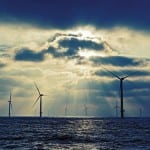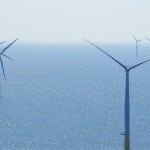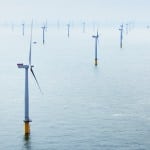Owner/operator: Vattenfall Wind Power
In September, the 300-MW Thanet Offshore Wind Farm, the world’s largest offshore wind energy facility, began operation off the southeastern coast of England. The wind farm has 100 3-MW turbines manufactured by Vestas. The facility will generate electricity equivalent to the annual consumption of more than 200,000 British households.
Located off the southeastern English coastline, the 300-MW Thanet Offshore Wind Farm has made history as the world’s largest offshore wind farm. The facility is placed offshore approximately 12 kilometers (km, about 7.5 miles) east of the Isle of Thanet, which is no longer an island but a peninsula jutting from the mainland. This historic location is where the Romans kicked off their invasion in the first century AD and where Augustine landed in AD 597 to begin his conversion of the pagans.
These days the Isle of Thanet’s coastline is once again being invaded. This time the invasion is being led by renewable energy companies such as Vattenfall that are seeking to exploit the area’s strong offshore wind resource in order to convert it into electricity.
Completed in September, the Thanet Offshore Wind Farm is expected to make a significant contribution to the United Kingdom’s (UK) national and regional renewable energy targets. The connection of Thanet’s 300 MW of capacity boosted the UK’s offshore wind capacity by more than 30%. The UK is banking on the boom in offshore wind projects to meet its renewable energy targets for 2020 under the European Union’s plan to cut carbon emissions, which contribute to climate change.
Offshore Wind Energy Takes Off
According to the American Wind Energy Association (AWEA), as of the end of 2009, 10 countries had wind projects installed offshore providing renewable electricity: Belgium, China, Denmark, Finland, Germany, Ireland, the Netherlands, Norway, Sweden, and the UK. Their projects account for a total offshore wind-installed and grid-connected capacity of approximately 2,072 MW.
Offshore wind energy generation has a number of advantages over land-based wind energy generation:
- Offshore wind turbines generate more power than on-shore turbines because wind speeds are generally higher and the wind is steadier offshore.
- Wind tends to be less turbulent offshore, which results in less wear on turbines.
- Larger turbines, which can capture more wind energy, are feasible offshore because transporting them to their installed location is easier via water.
- Offshore wind turbines can generate energy during times of high electricity use because of the “sea breeze effect” (typically hot summer afternoons when air over land heats up faster than air over the ocean, creating a difference in air density, resulting in denser air over the ocean expanding toward the land in the form of a “sea breeze”).
- Offshore wind farms can be located to generate energy near large population centers.
- Offshore power production can alleviate some transmission bottlenecks by generating power closer to demand.
- Offshore wind development could spur manufacturing, assembly, and transport activities in coastal cities.
According to AWEA, the research conducted in relation to offshore wind facilities’ impacts on the environment shows the following:
- Offshore wind farms are compatible with existing uses. For example, an offshore wind park will promote recreational fishing, as this activity can continue among the turbines.
- Wind turbines’ foundations can create artificial reefs for marine organisms to use.
- Extensive studies at European sites have revealed no significant bird impacts and have shown that, for the most part, birds avoid wind farms.
Since their inception in 1991, offshore wind projects in Europe have demonstrated their effectiveness. Known for their reliability, the 2,063 MW of offshore wind turbines in Europe generate electricity approximately 70% to 90% of the time, according to AWEA.
Despite its many merits, however, offshore wind energy has a number of challenges to overcome. Offshore wind power is still in its early stages compared to land-based wind power: At the end of 2009, only 1.3% of the more than 158,500 MW of wind generating capacity in operation worldwide was offshore.
One obvious challenge is that offshore technology has to operate in a more challenging environment than land-sited wind turbines. Severe weather conditions, which can limit access for routine maintenance, and the saline environment create the need for tougher turbine parts. Consequently, the latest generation of offshore turbines have been specially designed to handle the challenging offshore environment.
Financing Thanet
Vattenfall, the Thanet offshore wind farm’s owner, is a Swedish company and Europe’s fifth-largest generator of electricity. The company has operations in Belgium, Denmark, Finland, Germany, the UK, Poland, Netherlands, and Sweden.
The total investment spent on completing the wind farm was about £880 million (approximately $1.4 billion), according to Vattenfall. A portion of this total was spent locally, which meant benefits for local suppliers and services. Project management hired local contractors and workers to aid in the project’s development. As part of the project, a local maintenance facility was built in the Port of Ramsgate. In addition, 21 persons were hired to work at the facility.
Project Partners
The UK’s Crown Estate—owner of most of the territorial seabed—issued two rounds of development leases for offshore wind farms in the UK. Thanet is one of the first Round 2 offshore projects to be implemented.
Prior to the project’s construction, the project team prepared an environmental impact assessment to determine the effects on the local environment. The scope of these studies has been agreed upon by the appropriate UK government and environmental bodies. After receiving the necessary approval, the facility was built in the Thames Estuary on the easternmost part of the Kent coastline where the Thames River runs into the English Channel.
During construction of the Thanet wind farm, Vestas, the Danish wind turbine manufacturer, handled the design, supply, construction, testing, and commissioning of the 100 V90 wind turbines (Figure 1). Vattenfall took care of foundations, offshore and onshore cables with substations, and offshore installation vessels. A2SEA, the Danish offshore wind farm services provider, installed the turbines.
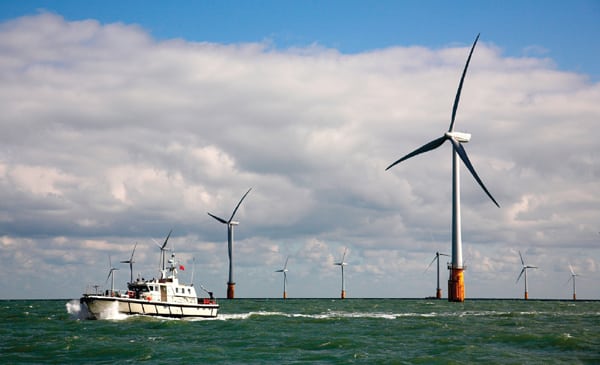 |
| 1. A seaworthy success. The 300-MW Thanet Offshore Wind Farm has 100 3-MW wind turbines manufactured by Vestas. Each turbine is 115 meters (approximately 377 feet) tall at its highest point and has a minimum clearance above sea level of 22 meters. Courtesy: Vattenfall Wind Power |
Vestas carries out maintenance of the turbines; a separate maintenance agreement with SLP Energy covers the turbines’ foundations.
The completed project’s 100 turbines cover an area of approximately 35 km2 (13.5 square miles). There are 500 meters (1,600 feet) between turbines and 800 meters between the rows. Average water depth is 20 to 25 meters. Water depth at the facility’s site ranges from 10 to 25 meters.
Two submarine power cables, which were manufactured by the Italy-based Prysmian Group, run from an offshore substation within the wind farm and connect to an existing onshore substation in Richborough in Kent County. From that point, the cables connect to two transformers. The offshore substation steps up the turbine voltage of 33 kV to 132 kV for the grid.
Meeting the UK’s Energy Needs
In September, the inaugural ceremony for the Thanet Offshore Wind Farm was held at sea with Vattenfall CEO and President Øystein Løseth and British Secretary of State for Energy and Climate Change Chris Huhne MP among the participants.
“I’m pleased that we’ve reached the point where 5 GW of our energy comes from onshore and offshore wind—that’s enough electricity to power all the homes in Scotland,” Huhne said “Getting these massive structures out here into the sea is a tremendous feat of engineering and I applaud all involved with this awesome achievement.”
“We are in a unique position to become a world leader in this industry,” he continued. “We are an island nation and I firmly believe we should be harnessing our wind, wave, and tidal resources to the maximum. I know that there is still more to do to bring forward the large sums of investment we want to see in low-carbon energy in the UK, and we as the government are committed to playing our part.”
Looking Ahead
The Thanet wind farm, which is currently the largest offshore wind facility, is projected to lose that distinction in the near future when the even larger London Array Offshore Wind Farm, which has an eventual goal of 340 turbines, is constructed. If completed according to current plans, the London Array, also located in the Thames Estuary, will assume the title of the world’s largest, and the first 1-GW, offshore wind farm.
The London Array will be built approximately 20 km off the coasts of Kent and Essex. The turbines will be installed on a 245-km2 site and the wind farm will be built in two phases. Phase One, planned to be completed in 2012, will cover 90 km2 and include 175 turbines with a combined capacity of 630 MW. If approved, the second phase will add enough capacity to bring the total to 1 GW. The London Array’s consortium consists of DONG Energy (50%), E.ON (30%), and Masdar (20%).
— Angela Neville, JD, is senior editor for POWER.






